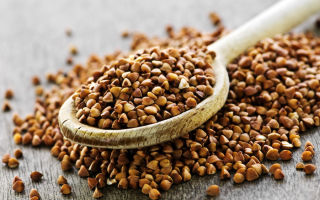Content
- 1 Buckwheat history
- 2 Composition, nutritional value and calorie content of buckwheat
- 3 The benefits of buckwheat
- 4 The use of buckwheat for weight loss
- 5 Is it possible to eat buckwheat every day
- 6 Daily intake
- 7 Features of the use of buckwheat for some diseases
- 8 The use of buckwheat in folk medicine
- 9 Useful properties of green buckwheat
- 10 The benefits of sprouted buckwheat
- 11 The use of buckwheat in cosmetology
- 12 How to cook buckwheat with benefit
- 13 The harm of buckwheat and contraindications to use
- 14 How to choose and store buckwheat
- 15 Conclusion
The benefits and harms of buckwheat are of interest to many fans of healthy eating. Delicious cereals are on the list of the most affordable foods - it is important to establish what effect it has on health.
Buckwheat history
Buckwheat, the fruit of a plant from the Buckwheat family, is a cereal with a huge history. The Himalayas are considered the homeland of buckwheat, it was there that, about 5000 years ago, the fruits of wild buckwheat first began to be eaten, and then they began to domesticate the useful cereal. From the region of the Himalayas, North India and Nepal, cereals began to spread throughout the world and came to the Mediterranean. Buckwheat was brought to Russia from Greece, which explains the Russian name for cereals.
Today buckwheat is grown in most countries of the world. The leaders in the production of cereals are the USA, Russia, France and the PRC.
Composition, nutritional value and calorie content of buckwheat
Groats are highly popular for a reason, but because of their rich internal composition. The cereal contains:
- subgroup B vitamins, from B1 to B6, B9;
- vitamins A and E;
- a nicotinic acid PP;
- calcium, iron, copper and phosphorus;
- potassium, sodium, magnesium and chlorine;
- boron and molybdenum;
- zinc and sulfur;
- silicon;
- starch;
- saturated and unsaturated fatty acids;
- disaccharides and monosaccharides;
- citric, as well as oxalic and malic acids;
- arginine and lysine - important amino acids from the category of essential;
- cellulose.
As for nutrients, about 57% of cereals are carbohydrates, about 12.5% are proteins, and only 3% are fats. The calorie content of kernel cereals per 100 g is 308 calories - this is the average nutritional value.
The benefits of buckwheat
Having familiarized yourself with the composition of cereals, you can draw important conclusions about the health benefits and dangers of buckwheat. With the constant presence in the diet, this cereal:
- has a cleansing effect on the body and helps to remove toxins from the intestines;
- strengthens the vascular walls and thereby takes care of heart health;
- lowers cholesterol levels, reducing the burden on the liver, and regulates blood glucose levels;
- has an antioxidant effect;
- supports the body's defenses by strengthening the immune system;
- is a valuable source of protein and amino acids and helps with anemia;
- has a beneficial effect on endurance and physical strength;
- has a positive effect on the nervous system and helps relieve anxiety and depression.
The benefits of buckwheat for women
The benefits of buckwheat for a woman's body are the rejuvenating properties of cereals.The presence of antioxidants in the composition helps to improve the condition of hair and skin.
In addition, buckwheat protects against the development of varicose veins, strengthens bone tissue, and has a positive effect on the reproductive system. It is recommended to eat cereals in case of hormonal disruptions and heavy painful periods.
The benefits of buckwheat in the morning on an empty stomach will be with weight loss. Groats have an average calorie content, but high nutritional value, so they do not harm the figure, but they help to lose weight.
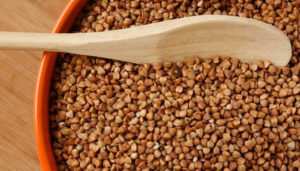
Why buckwheat is useful for men
The health benefits of buckwheat for men are the strengthening properties of cereals. Buckwheat helps to maintain physical activity and improves endurance. The use of cereals has a beneficial effect on blood circulation, thanks to this, not only blood vessels and the heart are strengthened, but also potency improves. Antioxidant properties protect men from reproductive diseases, in particular, from inflammation and tumors of the prostate.
Buckwheat for pregnant and lactating women
Buckwheat is one of the most valuable in the period of bearing a child. The benefits of buckwheat during pregnancy are that cereals replenish the supply of minerals and vitamins in a woman's body. Groats have a beneficial effect on the fruit - it protects it from oxygen starvation, supplies the baby's body with folic acid and proteins, reduces the risk of developing pathologies.
You can also eat cereals during breastfeeding. If the baby does not show any allergies, which happens quite rarely, the properties of buckwheat will contribute to the development of the child's bone, muscle and nervous system.
Buckwheat for children
Buckwheat is one of the most recommended cereals in the children's diet. For the first time, it can be offered to a child from 8 months in small portions without interrupting breastfeeding. The benefits of buckwheat for children are its nutritional value, hematopoietic properties, high content of important acids and minerals. There is no gluten in cereals, so allergies to it are extremely rare.
Buckwheat for athletes
Buckwheat is recommended for inclusion in sports nutrition. The fact is that it contains a large number of amino acids involved in the construction of muscle fibers, minerals that strengthen bones and ligaments. Groats help build muscle, help get rid of excess fatty tissue, and also increase the body's energy reserves.
The use of buckwheat for weight loss
Despite the high content of carbohydrates, cereals are digested for a rather long time, and are not deposited in adipose tissue. Groats are part of most diets - there are few calories in it, but the feeling of satiety lasts for several hours. When the product is included in the diet, you can expect more effective weight loss without harm to health.
It is most useful to eat cereals on a diet for breakfast, you can eat them during the day. The buckwheat diet will be most beneficial if you combine porridge with vegetables and sour milk products, fresh berries.
Is it possible to eat buckwheat every day
The benefits of buckwheat are so great that you can use the product daily. It won't hurt if you stick to small portions. However, cereals will bring even more benefits if you alternate them with other cereals, then the body will receive vitamins and other valuable substances evenly.
Daily intake
The benefits and harms of buckwheat for the human body are largely determined by the amount of the product. The recommended daily allowance for a healthy person is about 200 g. Buckwheat will be especially beneficial in the morning, it activates the metabolic system and helps to get a boost of vivacity and energy.
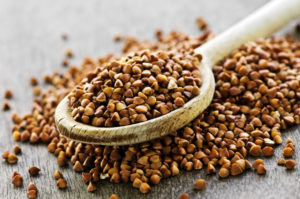
Features of the use of buckwheat for some diseases
Certain ailments require increased attention to the diet. In this regard, it is necessary to figure out whether it is possible to eat cereals for certain diseases.
With diabetes mellitus
Since buckwheat consists of slow carbohydrates and contains few sugars, the blood glucose level rises slowly and insignificantly after eating cereals. Also, cereals contain magnesium, and this element is necessary for the prevention and treatment of diabetes.
For diabetics, cereals are part of the permitted foods. However, doctors recommend slightly lowering the daily dose, for example, buckwheat for breakfast in the amount of 100-150 g will be beneficial.
With pancreatitis
In acute inflammation of the pancreas, patients are advised to refuse any food and wait until the pain subsides. About 7 days after the exacerbation ends, buckwheat porridge can be returned to the diet. However, you need to cook it in a special way - it should be as soft as possible, after a long soaking.
Boiled buckwheat will bring benefits for pancreatitis if you take crushed cereals or boil whole grains longer than usual. When the porridge is completely cooked, the grains will need to be removed, rubbed into a homogeneous puree and returned to the liquid; such a dish will not harm the irritated pancreas.
It is not recommended to supplement it with milk - buckwheat should be absolutely dietary, without any additives.
With gastritis
With an acute attack of gastritis, it is recommended to refrain from buckwheat. But 2-3 days after the onset of the attack, you can boil a liquid porridge. Buckwheat, flooded with water overnight, will benefit if after that you boil it by keeping it on fire a little longer than usual. It is not recommended to add salt and oil to porridge, they can harm an inflamed stomach.
The use of buckwheat in folk medicine
The healing properties of buckwheat can be used for a variety of ailments. Home medicine offers many recipes based on healthy grains.
With anemia
Buckwheat rich in iron and vitamins is the best medicine for anemia and anemia. It is recommended to take it like this - 150 g of cereals are pre-calcined in a frying pan, then ground into powder in a blender and mixed with 250 ml of water or milk. You need to store the product in the refrigerator, and use it 5 times a day in the volume of a large spoon.
For constipation
Buckwheat will benefit the intestines in case of problems with emptying the body. First, the cereals need to be fried for 4 minutes in a pan, and then pour water in a ratio of 1 to 3 and boil under the lid without stirring. Groats have a mild laxative effect, so if you are constipated, you can eat them twice or three times a day.
With diarrhea
Steamed buckwheat is beneficial for diarrhea; it retains the most valuable properties. Porridge should be consumed three times a day. Adults can eat 100 g of porridge, children need to offer cereal a large spoonful at a time.
With rheumatism
The beneficial properties of buckwheat and its mineral composition help to improve the condition of the joints. With rheumatism, it is recommended to regularly consume ordinary buckwheat without salt. Boiled buckwheat or cereal soaked in water overnight will benefit - add 2 large spoons of cereal to a glass of water.
For joint pain, it is useful to make buckwheat compresses. To create them, the grains are first turned into a fine powder, and then diluted with water to a thick dough and the mixture is applied to the diseased area for several hours.
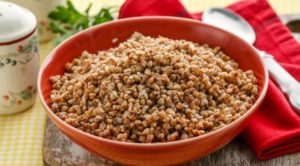
With oncology
The cereal contains an important substance - quercetin, which helps suppress cancer cells. Therefore, there is a special anti-cancer diet, which can be used both for prevention and as an additional therapy.
According to this diet, you need to take at least 300 g of buckwheat per day - this allows you to get up to 24 g of quercetin.
With atherosclerosis
With weakened vessels, buckwheat broth is beneficial. They do it like this - grits are ground into powder, poured with a small amount of water and boiled until the powder acquires the consistency of a thin jelly. Buckwheat decoction will bring benefits if you drink 30 ml of it twice a day.
For various skin diseases
With psoriasis, dermatitis, eczema and furunculosis, the benefits of raw buckwheat in the form of compresses are manifested.
They do it like this:
- grits are ground into powder;
- then slightly dilute the powder with water until a doughy state;
- a small cake is formed from this mixture;
- apply it to the diseased area of the epidermis.
The cake must be fixed with a bandage and held for 3 hours, and then the compress must be removed.
In case of skin diseases, it is definitely recommended to use buckwheat internally. Acids, vitamins and other beneficial substances contained in this cereal will have an anti-inflammatory effect and help improve the condition of the epidermis.
Useful properties of green buckwheat
Buckwheat acquires the usual dark brown color when frying. But there is also raw buckwheat - green, in recent years it can also be found in stores. These are completely fresh grains that have not undergone heat treatment and have managed to preserve the beneficial properties of buckwheat in full.
Useful properties of green buckwheat consist in the fact that it is especially effective in cleansing the body of toxins and toxins - grains contain a lot of fiber. Also, due to the increased amount of antioxidants, green cereals have excellent anti-cancer properties. Fatty acids in green buckwheat strengthen the nervous system and boost immunity, as well as promote rapid cellular renewal.
It is customary to cook green buckwheat by steaming in boiling water. This means that a small amount of cereal is simply poured with water for several hours and waiting for the buckwheat to soften. After that, you can warm it up, add salt, pour milk or add a little butter.
The benefits of sprouted buckwheat
Green buckwheat groats can be boiled, but this makes no sense, since during heat treatment it loses most of its benefits. Much more often it is simply steamed in boiling water or germinated.
The main valuable property of buckwheat sprouts is a huge amount of dietary fiber in the product. The use of sprouted grains allows you to qualitatively regulate bowel movement, improves appetite and promotes the proper absorption of nutrients.
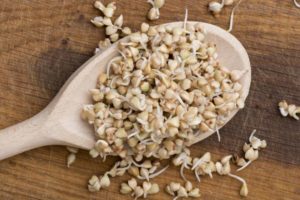
The benefits of buckwheat for the liver are especially great in sprouted form. The sprouts, added to salad or as a side dish to other dishes, remove toxins from the body and reduce the burden on the liver. Sprouted buckwheat is often part of diets aimed at losing weight, it helps to quickly lose extra pounds, not to encounter a deficiency of nutrients and, thus, not to harm yourself.
The use of buckwheat in cosmetology
Groats are used not only for culinary purposes. Buckwheat grains are actively used in home-made recipes for personal care, or rather, they use useful powder obtained from buckwheat or soft boiled porridge. The product nourishes the skin and increases its elasticity, gently and carefully removes dead cells of the epidermis, allows you to deeply cleanse the skin.
For example, the following useful mask can be used against wrinkles:
- the cereals are boiled to a crumbly state and 15 g of porridge are measured - this amount will be enough for a mask;
- soft grains are mixed with egg yolk and 20 drops of almond oil are added;
- the mixture is gently applied to the previously steamed face skin.
You need to keep the product for about half an hour, after which the composition is washed off the skin with warm water. Vitamins have time to penetrate deep into the layers of the epidermis, buckwheat has a tightening and rejuvenating effect.
You can also make a high-quality homemade scrub from cereals. They do it like this:
- a small amount of cereal is ground into a homogeneous flour - the powder should turn out to be one large spoon;
- flour is mixed with 3 large tablespoons of natural cherry juice;
- the mask is brought to homogeneity and applied to the cleansed face for 7 minutes.
Buckwheat powder gently massages the skin and removes keratinized particles from it. The skin after such a mask is especially soft and tender, but the procedure should not be done too often. Better to do it once every 3 weeks, otherwise the skin can be harmed.
How to cook buckwheat with benefit
The traditional method of cooking cereals is the usual boiling until all the moisture has completely evaporated from the buckwheat. However, nutritionists believe that the special benefits of buckwheat for the stomach and other organs will be, if not boil, but only steamed porridge.
In the process of cooking, porridge loses almost 30% of its beneficial properties. Therefore, it is much better to pour boiling water over it overnight and leave it under the lid until morning so that the cereal has time to soften. In the morning, it only remains to warm it up, and the benefits of undercooked buckwheat will be maximum.
The harm of buckwheat and contraindications to use
Grains have so many useful properties that almost everyone can eat them. But even buckwheat has certain contraindications, so as not to harm yourself, you need to know about them.
It is not recommended to eat buckwheat:
- with an acute attack of pancreatitis;
- with renal failure;
- with gastritis or stomach ulcers during an exacerbation;
- with food allergy to buckwheat.
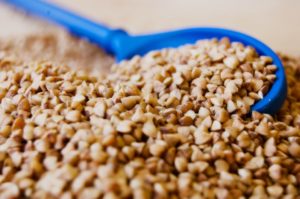
In addition, in some conditions, it is necessary to be careful in the use of buckwheat. Groats should not be eaten in large quantities with a tendency to constipation or gas formation; it is necessary to monitor the volume of porridge during pregnancy and lactation. Diabetics should carefully approach buckwheat - in excessive quantities, nutritious cereals can be harmful.
There are mono-diets on buckwheat porridge, but you can follow them for no more than 4 days in a row, otherwise such food will not be beneficial, but only harm.
How to choose and store buckwheat
Buckwheat is sold in any store, but when choosing a product, you must adhere to certain rules.
- The packaging of cereals must be completely sealed, if the bag is torn, there is a high risk of contamination of the product with harmful microorganisms or pests.
- The groats inside the bag should be homogeneous, if the packaging contains a lot of garbage and husks, and the grains differ noticeably in size, this indicates low quality.
- The shelf life of cereals should not come to an end, the fresher the product, the more benefits it will bring.
At home, it is recommended to sniff the cereal before eating. Spoiled cereals give off a distinct rancid smell - such grains must be thrown away, they will cause harm.
As for storage, it is best to keep cereals in a dark and dry cabinet in an airtight container with a lid. In an open bag, buckwheat can be saturated with the smells of other products and spices, and there is a high risk of infection by insects. The shelf life of cereals is about a year, subject to proper storage.
Conclusion
The benefits and harms of buckwheat depend mainly on the amount of the product. In small dosages and with proper preparation, cereals will undoubtedly be beneficial for the body, and its properties will help in curing a number of diseases.

